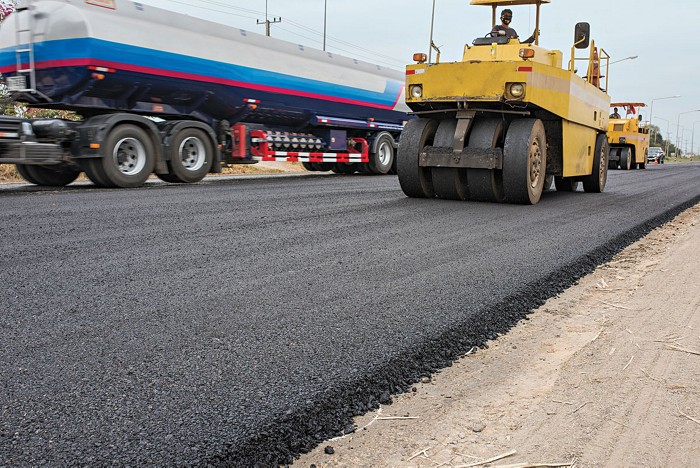A1 Professional Asphalt & Sealing Llc Fundamentals Explained
A1 Professional Asphalt & Sealing Llc Fundamentals Explained
Blog Article
The smart Trick of A1 Professional Asphalt & Sealing Llc That Nobody is Talking About
Table of ContentsSee This Report on A1 Professional Asphalt & Sealing LlcThe 7-Second Trick For A1 Professional Asphalt & Sealing LlcThe Best Guide To A1 Professional Asphalt & Sealing LlcThe smart Trick of A1 Professional Asphalt & Sealing Llc That Nobody is DiscussingRumored Buzz on A1 Professional Asphalt & Sealing Llc

The oil in a vehicle engine is not simply oil. It includes a range of ingredients to boost the vehicle's performance. These include polymers, viscosity modifiers, heat stabilizers, extra lubes, and put on ingredients. The REOB contains all the additives that remained in the waste oil as well as the wear steels from the engine (mostly iron and copper).
Nonetheless, by making many blends using various REOB examples and various asphalt binders, the variants greatly can be averaged out. A number of States provided examples of known REOB structure to TFHRC scientists, who analyzed the samples to contrast the percentage of included (known) REOB to the located (tested) quantity. The evaluations showed a similar portion of added and discovered REOB.
Fascination About A1 Professional Asphalt & Sealing Llc
They got an overwhelming feedback. The TFHRC scientists examined 1,532 samples from 40 States, one Canadian province, and 2 Government Lands Freeway departments. They evaluated each sample twiceamounting to greater than 3,000 evaluations. None of those States understood that the asphalt they were buying contained REOB. One State urged its examples had no REOB.
Of the 1,532 samples evaluated, 12 percent contained REOB, and some had appreciably high degrees of it at 1020 percent. The highest possible degree was 34 percent in an example from Texas, which TxDOT had made use of in a patching substance. This screening likewise revealed the visibility of phosphoric acid in 11 percent of the examples, and 2 percent consisted of ground tire rubber.
2 years back at TRB's annual meeting, the Federal researchers held an REOB workshop and offered the searchings for of their lab examinations to a standing room-only crowd. Some firms do not specifically prohibit REOB, they do enforce physical tests that avert its useeffectively a ban. Others do not ban it by spec, however have agreements with asphalt suppliers to stay clear of using REOB
What Does A1 Professional Asphalt & Sealing Llc Mean?
A handful do permit REOB, some within certain restrictions. Ohio and Texas restriction degrees to less than 5 percent of the asphalt. To establish a dependable test approach that all States can utilize, the TFHRC researchers established a round-robin test strategy. The individuals are 11 State freeway companies (Illinois, Massachusetts, Minnesota, Mississippi, Montana, North Carolina, Oklahoma, South Carolina, Texas, Vermont, and Wyoming), 2 independent testing laboratories, the Ministry of Transportation in Ontario, Queen's University in Ontario, and an Ontario paving service provider.
The individuals are evaluating the examples individually utilizing the standards offered by the TFHRC scientists. The outcome will be a proposed AASHTO examination technique that any kind of State can embrace and use.
The pavement with REOB, which lies 0.6 mile (1 kilometer) from the pavement without REOB, has similar subgrade, website traffic thickness, and climate. Nevertheless, the sector of Highway655 with 5 to 10 percent REOB revealed significant breaking. In this instance, the presence of REOB was the recognized reason of cracking at a reduced temperature levels.
A section of examination pavement in Minnesota (MN1-4) found to contain REOB also fractured too soon. The pavement done well for the initial 3 to 4 years, however then began to fracture.
About A1 Professional Asphalt & Sealing Llc
The examinations were not substantial, but they revealed that at levels of 6 percent or more, the tensile stamina of the asphalt dropped dramatically. At a degree of 3.5 percent REOB, the variant in the physical test techniques was above the impact of REOB. As a matter of fact, it was hard for researchers to analyze whether REOB existed.

One binder parameter considered is the distinction between the reduced temperature critical requirements temperature level for tightness (S) in the bending light beam rheometer and the flexing beam of light rheometer creep slope (m-value) noted as Tcritical. Two independent research groups, one from AASHTO and the various other from the Asphalt Institute, concluded that even more research is required on the use of REOB in asphalt.
Previously, all asphalt screening determined design residential properties such as rigidity. These examinations do disappoint what products had been contributed to the asphalt. One sample obtained during the TFHRC study had a really odd evaluation. The sample had the following examination results: Superpave PG 64-28 with a heat grade of 67.3 Tcritical on the flexing light beam rheometer was 6.7 degrees Celsius.

A1 Professional Asphalt & Sealing Llc Can Be Fun For Everyone
These outcomes show weblink there are weaknesses in the standard design testing protocols that might be manipulated. The manufacturer might have an economic advantage and the item passes all the standardized tests, yet the product might not be useful to guaranteeing lasting performance. To resolve this problem and the development of new asphalt ingredients and extenders, TFHRC is starting a research study program to make use of handheld spectroscopic gadgets, x-ray fluorescence spectroscopy, and Fourier change infrared spectroscopy to enable analyses to be carried out in the area rather than having to take examples back to the lab.
Report this page